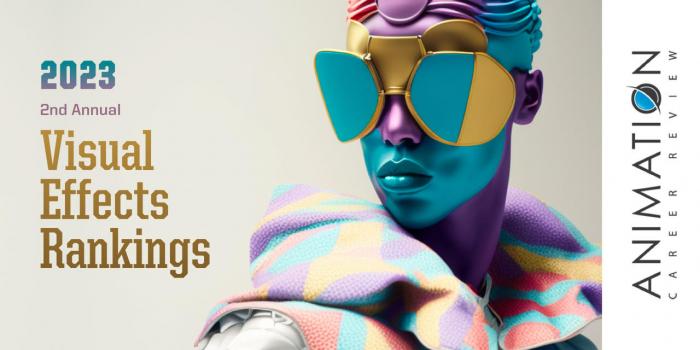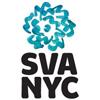

What are the top private Visual Effects schools for 2023?
| Ranking | School | State |
|---|---|---|
| 1 | Gnomon School of Visual Effects | California |
| 2 | Savannah College of Art and Design | Georgia |
| 3 | University of Southern California | California |
| 4 | School of Visual Arts | New York |
| 5 | Academy of Art University | California |
| 6 | The Digital Animation & Visual Effects School | Florida |
| 7 | ArtCenter College of Design | California |
| 8 | Rochester Institute of Technology | New York |
| 9 | Carnegie Mellon University | Pennsylvania |
| 10 | Otis College of Art and Design | California |
Our 2023 list of the Top 10 Private Visual Effects Schools in the US, our second annual rankings for VFX. For an explanation of ranking criteria, click here.

The VFX Program at Gnomon prepares students for immediate employment in the entertainment industry. For students seeking careers in Visual Effects (VFX), Gnomon has a Digital Production BFA Program with a VFX Concentration. Program benefits include small class sizes of approximately 14 students; a studio-environment consisting of a 35,000 square foot lot within the historic Television Center Studio lot; and instructors who are working professionals in the VFX, Games, and Animation industries.
The Digital Production BFA with a VFX Concentration consists of 180 total units, with 135 within the field of career-focused study and 45 in general education. Within the program’s 135 career-focused units are 30 units of concentration-specific courses. Examples include Principles of VFX, Liquid Simulations, Virtual Production, VFX Design, Motion Capture, Dynamic Effects 1-4, and VFX for Games.
The Digital Production BFA at Gnomon can be completed in 12 terms over three to four years. The program culminates with the creation of a professional demo reel that showcases the students best work.
For students seeking a shorter path, Gnomon has a Digital Production Certificate consisting of eight terms completed over two years. This option has a Visual Effects Animation Emphasis Area. Course examples include Animation and Visual Effects 1-2, Dynamic Effects 1-4, and HD Digital Filmmaking for Visual Effects. Certificate students will graduate with a demo reel of their best work.
All Gnomon students receive training in industry software such as After Effects, Houdini, Nuke, V-Ray, Photoshop, ZBrush, and Maya.
With a 98% placement rate, Gnomon has 900+ industry-employed graduates to date. Alumni are VFX Artists, Gameplay Animators, Character Artists, Cinematics Animators, and Environment Artists, at some of the world’s top studios. Examples include Walt Disney Animation Studios, DreamWorks, Industrial Light & Magic (ILM), Nickelodeon, Netflix, Fox, Paramount, Framestore, and Sony Pictures Animation.
Located in Hollywood, California, Gnomon has been dubbed the “MIT of Visual Effects” by Fast Company Magazine. Established in 1997 and serving more than 550 students, the school provides degree and vocational certificate programs, as well as 100+ individual 10-week course options. Gnomon is accredited by the Accrediting Commission of Career Schools and Colleges (ACCSC).

The Visual Effects (VFX) Program at Savannah College of Art and Design (SCAD) has produced 86 alumni who contributed to 19 Academy Award nominated films in 2020. Examples include Star Wars: The Rise of Skywalker, Frozen 2, Avengers: Endgame, Toy Story 4, and A Beautiful Day in the Neighborhood.
SCAD VFX students have the unique opportunity to work with big brands through SCADPro—the school’s in-house design studio. Outside of SCADPro, students have opportunities create visual effects and animations with premium software such as Pixar's RenderMan, Autodesk Arnold, Nuke, Maya, Resolve, Adobe Substance 3D Painter, and Houdini. Students also have access to more than 800 networked computers and a 60,000 square-foot, state-of-the-art digital media center consisting of a green screen lab, a 75-seat in-house theater, and studio environment.
The VFX Programs at SCAD are part of the School of Animation and Motion. Three degree pathways are available including a BFA, MA and MFA. The BFA and MFA Programs are available at the Atlanta and Savannah campuses. The MA Program is available at the Savannah campus only.
At all degree levels, SCAD VFX students receive instruction from award-winning professors who have worked at major studios and on award-winning productions such as The Lion King, Pocahontas, and Ice Age. Course examples for the BFA Program include Storyboarding Essentials, Digital Visual Effects, Visual Effects Studio I-II, Concept Development for Visual Effects, Visual Effects-based Cinematography, and Professional Development for Visual Effects. VFX BFA students have the option to complete an internship, 500-level SCADpro Elective, or a Business-focused Elective.
MA Students will take courses such as Programming Concepts for Visual Effects, Modeling for Visual Effects, Visual Effects Theory and Application, Visual Effects MA Studio and Visual Effects Portfolio. The Graduate Internship is optional. MFA students will take courses such as Visual Effects Studio I: Preproduction, Visual Effects Studio II: Production, Particles and Procedural Effects: Stochastic and Calculated Methodologies, Visual Effects Theory and Application, and Digital Compositing II: Advanced Studies of Multi-layered Integration. The Graduate Internship is required as well as successful completion of the Visual Effects MFA Thesis.
Graduates of the VFX Programs at Savannah College of Art and Design hold positions such as Visual Effects Artists, CGI FX CGI Technical Directors, 3D Environment Artists, Lighting Technical Directors, VFX Producers, Previsualization Artist, Digital Compositors, and Look Development Artists at major studios around the world. SCAD graduates work at Blizzard Entertainment, Disney, Pixar, DreamWorks Animation, Shade VFX, Pixomondo, and Blur Studio.
Providing more than 100 degree program options and over 75 minors and certificate programs, Savannah College of Art and Design (SCAD) has more programs and specializations than any other art and design college in the U.S. Founded in 1978, the school opened in 1979 with just 71 students, one classroom, and an administration building. Today, SCAD serves more than 15,000 students across campuses in Atlanta and Savannah, Georgia, and Lacoste, France. Savannah College of Art and Design is accredited by the Southern Association of Colleges and Schools Commission on Colleges (SACSCOC).

University of California (USC) houses the School of Cinematic Arts (SCA), home to the John C. Hench Division of Animation + Digital Arts (Hench DADA). This competitive Division is multidisciplinary, allowing students to focus their studies in areas from Visual Effects (VFX) and Character Animation to Motion Graphics and Visual Storytelling. Hench DADA students also have the unique opportunity to collaborate on projects with students in the Interactive Games Division, Thorton School of Music, the Production (Live Action) Division, and Kaufman School of Dance.
Specific program options for students interested in VFX include the Hench DADA Animation + Digital Arts BFA with a Concentration in Visual Effects and the SCA Game Art BFA with a Concentration in Visual Effects. Course examples across programs include Visual Effects, The World of Visual Effects, Digital Effects Animation, Live Action Integration with Visual Effects, 3D Modeling, Animation, and Visual Effects, Programming in Python, Digital Lighting and Rendering, Organic Modeling for Animation, and Production.
Students in any SCA Program (from Producing to Film & Television Production) may add the 3D Animation Minor, which provides the opportunity to focus in Visual Effects, Virtual Reality, or Motion Capture. The Minor consists of 16 units, with course options such as Visual Effects, Live Action Integration with Visual Effects, and The World of Visual Effects. Students in all programs will complete a final project.
Graduates of the VFX Programs at the University of Southern California work for studios such as Industrial Light & Magic (ILM), Pixar, Digital Domain, DreamWorks Animation, Illumination, Nickelodeon Animation, and Sony Pictures. Many USC alumni have gone on to launch their own studios and freelance businesses.
Established in 1880, University of Southern California is the oldest private research university in California. The school employs approximately 28,120 faculty and staff that serve 49,000 students, making USC the largest private sector employer in the City of Los Angeles. University of Southern California provides 600 graduate and professional programs across 23 schools, academic divisions, and research institutes. Programs are offered in the areas of business, law, engineering, film, occupational therapy, pharmacy, and medicine. University of Southern California is accredited by the WASC Senior College and University Commission (WSCUC).

The School of Visual Arts (SVA) has a 3D Animation and Visual Effects BFA Program, which features classes taught by award-winning instructors in computer labs, production studios, and dedicated suites. The computer labs house the same hardware and software used by professionals in the Animation and Visual Effects (VFX) industry. Students can access the lab 24/7 remotely, off-campus.
The BFA Program emphasizes learning by doing. Students in the Program have the opportunity to develop Animation and VFX skills by working with alumni-owned studios such as Titmouse, Augenblick, and Plymptoons.
Consisting of four years of study, the SVA 3D Animation and Visual Effects BFA Program requires 120 credit hours including 72 credits in studio art courses; 30 credits in humanities & sciences courses; 15 credits in art history courses; and three elective credits from any area. Course examples include VFX and Compositing I and II, VFX and Motion Graphics III and IV, VFX Animation with Houdini, Advanced Python for Technical Directors, Color Grading, Character FX I, Production Skills I and II, Advanced Compositing Techniques, and Virtual Reality Design.
The 3D Animation and Visual Effects BFA Program at School of Visual Arts culminates with a Thesis Film to be screened by industry professionals.
Graduates have gone on to win awards from the Academy of Motion Pictures and at major festivals. SVA BFA alumni can be found at major studios such as Lucasfilm Animation, Sony Pictures Animation, Disney Animation Studios, Warner Bros. Animation, Nickelodeon, and DreamWorks. Some SVA graduates go on to work for independent animation studios worldwide or to launch their own studios or freelance businesses.
School of Visual Arts opened in 1947 as the Cartoonists and Illustrators school. Classes began with just three teachers and 35 students. Today, School of Visual Arts serves approximately 4,110 students enrolled in dozens of BFA, MA, MFA, and MPS programs. SVA is accredited by the Middle States Commission on Higher Education (MSCHE), with individual program accreditation by the National Association of Schools of Art and Design (NASAD) and the Council for Interior Design Accreditation (CIDA).

The School of Animation & Visual Effects at Academy of Art University (Academy of Art) is a STEM Certified School that is the only Animation & VFX school that teaches in a studio production environment known as Studio X. This collaborative, in-house, student-run production studio has real-world clients, allowing students to obtain credits before they graduate. Studio X students have been credited on films such as Beasts of the Southern Wild, Fruitvale Station, and many others.
Academy of Art University has four programs for students seeking a career in VFX. Options include the AA, BFA, MA, and MFA in Animation & Visual Effects (VFX). Academy of Art also has an Animation and VFX Certificate Program that allows students to skip the Liberal Arts coursework and dive right into Animation and VFX.
Course examples across programs include Producing for Animation & Visual Effects 1, Cinematics for Animation & VFX, Physics for Artists: Light, Sound, and Motion, History & Technology of VFX and Computer Animation, Storyboarding, Principles, Visual Effects for Animation, 3D Character Animation 3, Lip Sync & Facial Performances, Fundamentals of Lookdev & Lighting, 3D Animation Physics and Mechanics, 3D Modeling & Animation 1 (Maya), and Careers in Animation & VFX.
Across programs, students have opportunities to complete an internship, study abroad experiences, and a professional demo reel and/or portfolio. Graduates of the School of Animation & Visual Effects at Academy of Art University are prepared for careers in the Entertainment industry.
Program alumni have been hired at major companies and studios such as Industrial Light & Magic (ILM), Google, Sony Pictures Imageworks, Weta FX, Walt Disney Animation Studios, Sony Pictures Animation, Riot Games, LAIKA, Marvel, and CASA VFX.
Academy of Art University is a family-owned private university located in San Francisco—one of the world’s top cities for animation careers. Established in 1929 and serving more than 7,000 students, Academy of Art is of the nation’s largest private art and design schools. Divided into 22 schools, Academy of Art University offers more than 129 degree programs in 40+ areas of study. Programs lead to the AA, BA, BFA, BS, B. Arch, MAT, MA, MFA and M. Arch degrees.
The Academy is accredited by the WASC Senior College and University Commission (WSCUC).

The Digital Animation & Visual Effects School (DAVE School) has a Visual Effects Production (VFX) Program with two option including a 12 month Diploma consisting of 60 credits and the 32 month Bachelor’s degree consisting of 120 credits. Students in both programs will master industry software such as Maya, Unreal Engine, and After Effects, while working their way through the production process from start to finish.
Both program options are taught in a flexible, hybrid format that combines live, online classes with studio residencies held at the Orlando, Florida campus. Courses for the program are project-based, and include titles such as Dynamics and Visual Effects for Motion Graphics, VFX & Compositing, Emerging VFX Tech & Pipelines, Digital Compositing, Character, Prop and Environment Modeling, Rotoscoping, 3D Animation for Motion Graphics, and Level Design. DAVE School students will also learn the basics of creating a start-up.
Students in all DAVE School programs will build a demo reel and create a portfolio. Graduates work at major studios around the world. Some DAVE School alumni go on to launch their own studios or freelance businesses.
The Digital Animation & Visual Effects (DAVE) School was founded in 2000. Located on the backlot of Universal Studios, Florida, The DAVE School is an academic unit of NUC University, which is accredited by the Middle States Commission on Higher Education (MCSHE). DAVE serves around 1,000 students enrolled in six programs leading to a Bachelor’s degree or Diploma.

The Entertainment Design Program at ArtCenter College of Design (ArtCenter) allows students to customize their coursework in an area of their choosing. This includes Visual Effects (VFX), Feature Animation, Video Games, and more. Leading to a BS, the Program, also has a number of established Tracks that are suitable for students who would like to launch a career in VFX. Examples include Concept Design, Animation, and Game Design.
Students in all Tracks and self-designed Specializations have access to VFX courses such as Character Design, Concept Design 1 & 2, Worldbuilding, Entertainment Design 1 &2, How Things Work, Light and Color, Visual Structure, Rendering and Lighting, Production Design, Film, and Light and Color. Students will also complete Portfolio/Senior Project 1 & 2, and the 8th Term Portfolio Review.
ArtCenter College of Design graduates are prepared to pursue positions in all areas of Film and Entertainment. ArtCenter alumni have been hired at top companies and studios such as Apple, DreamWorks, Blizzard Entertainment, Microsoft, Marvel, Paramount, Walt Disney Imagineering, Google, Riot Games, Amazon, The WB, Netflix, and Mattel.
ArtCenter College of Design serves approximately 2,320 students from more than 50 countries. Founded in 1930, ArtCenter has campuses in Pasadena and Los Angeles, California, and satellite studios in Petersen Automotive Museum (Miracle Mile, Los Angeles) and Berlin, Germany. ArtCenter offers 11 undergraduate programs, seven graduate degree programs leading to an MFA or MS, a joint MS/MBA program, and undergraduate minors for Business, Creative Writing, and Social Innovation students.
ArtCenter College of Design is fully accredited by the WASC Senior College and University Commission (WSCUC) and the National Association of Schools of Art and Design (NASAD).

The School of Film and Animation at Rochester Institute of Technology (RIT) is a Designated Center of Excellence (COE) by Toon Boom Animation. Housed in the College of Art and Design, the School has a program that explores Animating for Digital and Visual Effects; Games; Augmented and Virtual Reality (AR/VR), and Films. Leading to a Film and Animation BFA, this multidisciplinary Program consists of courses such as Digital Effects & Compositing, Particles & Dynamics, After Effects for Animators, World Building Workshop, Virtual Production I-II (explores real-time visual effects), Film Sound Theory: Effects, Production, Computers and Imaging Technology, Production Process, and Building the 3D Characters.
Other Program features include a variety of internship opportunities at local and regional studios and companies; cooperative education (co-op) in the College of Art and Design, which provides hands-on experience in a professional environment; and Study Away: LA, which allows students to spend a semester in Los Angeles, where they can intern at top studios and entertainment companies, and take two courses to complement the experience.
Film and Animation students at Rochester Institute of Technology also have access to the 52,000 square foot MAGIC Spell Studios, along with labs and classrooms outfitted with industry standard technology and software. At all levels, students may participate in the RIT’s Creative Industry Day, where they have the opportunity to interact with representatives of studios, design firms, and other creative companies.
Graduates of the Film and Animation Program at Rochester Institute of Technology are prepared to pursue positions such as VFX Artist, Effects Animator, Director, Visual Effects Supervisor, 3D Modeling and Character Designer, and Production Manager. RIT alumni have been hired at major studios such as Disney, Industrial Light & Magic (ILM), Sony, DreamWorks, Lucasfilm, Electronic Arts (EA), Dolby, and Nickelodeon.
Rochester Institute of Technology is a top research university that dates back to 1829. With global campuses in China, Croatia, Dubai, and Kosovo and serving more than 19,000 students from 50 states and over 100 nations, RIT is also one of the largest private universities in the U.S. Students at RIT have access to more than 200 academic programs across 11 colleges and institutes. Rochester Institute of Technology is accredited by the Middle States Commission on Higher Education (MSCHE).

Carnegie Mellon University (CMU) is home to the Integrative Design, Arts and Technology Network (IDeATe). In collaboration with the Robotics Institute in the School of Computer Science, IDeATe manages eight undergraduate areas that can be taken as minors. This includes Animation & Special Effects.
Led by faculty with expertise in Art and Robotics, course examples for the Animation & Special Effects Minor include Special Topics in Animation: Storytelling Through Effects; Character Rigging for Production; Experimental Capture; Digital Realities: Introducing Immersive Technologies for Arts and Culture; Animation, Art and Technology; Physical Computing; IDeATe Portal: Creative Kinetic Systems; and Little Games/Big Stories: Indie Roleplaying Game Studio.
The Animation & Special Effects Minor is open to students in any program. Examples include Film and Visual Media; Art; Video and Media Design; and Electronic and Time Based Media.
Graduates of the IDeATe Programs at Carnegie Mellon University have been hired at major studios and networks such as Electronic Arts (EA), Comedy Central, DreamWorks Animation, Warner Bros. Games, Activision Blizzard, Paramount, Sony Interactive Entertainment, Walt Disney Studios, Zynga Games, and MTV.
Founded in 1900 by industrialist and philanthropist Andrew Carnegie, Carnegie Mellon University began as Carnegie Technical Schools. Today, the school serves around 15,800 students enrolled in more than 200 programs across seven colleges and schools. CMU also has more than a dozen degree-granting locations, and over 20 research partnerships in Silicon Valley, Australia, Africa, and Qatar. A private, global research university, Carnegie Mellon University is accredited by the Middle States Commission on Higher Education (MSCHE).

Otis College of Art and Design (OTIS) has nine BFA Programs that allow students to expand and customize the curriculum through one of 17 Minor options. BFA students may also add a Certificate to enhance any undergraduate program. An ideal choice is the Motion Graphics Certificate, which focuses on Visual Effects (VFX), Film Editing, Animation, and Digital Skills. Students will master software such as Adobe Premiere, After Effects, and Cinema 4D, and develop skills in Music and Sound Editing, Digital Storytelling, and Background and Character Development.
The OTIS Motion Graphics Certificate Program culminates with a professional-quality portfolio of the students best VFX or other works. Students can complete the Program in 18-24 months.
In addition to the Certificate Program, OTIS has a Digital Media Minor that explores both traditional and digital skills related to VFX, Animation, Motion Graphics, Film, Video Games, and more. Course examples include Motion Design, Game Design, 3D for Storytellers, Animation, and Storytelling for Digital Artists.
Specific OTIS BFA Programs for students interested in VFX include Game & Entertainment Design and an Animation. Across Programs, students will take VFX-related courses such as Motion Graphics I-II and 2D and 3D Computer Animation. Students will also master industry-standard software such as Maya, Houdini, Unreal Engine, Nuke, Cinema 4D, and After Effects.
Across programs, students will begin their studies with the immersive OTIS Foundation Program. During this one-year requirements, students will take studio courses across both the Visual Arts and Design disciplines. Course examples include Connections Through Color and Design, Form and Space, Creative Practices, Drawing and Building Form, and Creative Practices I-II.
Graduates of the BFA, Certificate, and Minor Programs at Otis College of Art and Design are prepared for careers such as VFX Artist, Effects Animator, Unreal Engine Artist, Real-Time Development Artist, Unreal Engine Animator, Character Animator, 2D/3D CG Artist, Cinematic Animator, Rotoscope Artist, Match Mover, Modeler, Background Artist, Animatic Designer or Producer, Storyboard Artist, and Animator.
Program alumni have been hired for VFX positions at Industrial Light & Magic (ILM), Sony Pictures Imageworks, Mattel, New Deal Studios, and Hydraulx. Other OTIS BFA graduates have been recruited by Apple, Disney, Pixar Animation Studios, DreamWorks Animation, Nickelodeon, Digital Domain, Weta FX, Mattel, Blizzard Entertainment, LucasArts, Nike, Electronic Arts (EA), Cartoon Network, and Netflix.
Established in 1918, Otis College of Art and Design is Los Angeles’ oldest professional school of the arts. This private, non-profit college serves more than 1,200 students enrolled in 11 BFA and MFA degree programs in the Fine Arts, Graphic Design, Public Practice, and Writing. A variety of minors and certificate programs are also available. Programs and courses at OTIS are led by more than 430 professors—all active professionals in their respective fields.
Otis College of Art and Design is accredited by the WASC Senior College and University Commission (WSCUC) and the National Association of Schools of Art and Design (NASAD).OTIS is also a member of the Association of Independent Colleges of Art and Design (AICAD) and the Partnership for Academic Leadership on Sustainability (PALS).
